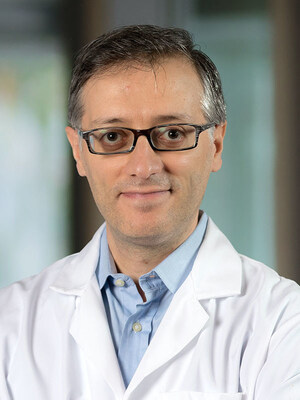BRONX, N.Y., June 22, 2018 /PRNewswire-USNewswire/ -- It's been known for years that humans and other mammals possess an antiviral gene called RSAD2 that prevents a remarkable range of viruses from multiplying. Now, researchers at Albert Einstein College of Medicine, part of Montefiore, have discovered the secret to the gene's success: The enzyme it codes for generates a compound that stops viruses from replicating. The newly discovered compound, described in today's online edition of Nature, offers a novel approach for attacking many disease-causing viruses.
"Nature has given us a template for creating a powerful and safe antiviral compound," says study leader Steven C. Almo, Ph.D., professor and chair of biochemistry, professor of physiology & biophysics and the Wollowick Family Foundation Chair in Multiple Sclerosis and Immunology at Einstein. Dr. Almo and his colleagues at Einstein and Pennsylvania State University found that the compound, called ddhCTP, disrupts the replication machinery of Zika virus. The next step is to test the compound against a broad array of viruses.
Dr. Almo predicts that modifications to ddhCTP could make it even more potent. Furthermore, he says, "drugs based on this compound may have a favorable safety profile. We've been living with ddhCTP for many millions of years and long ago developed mechanisms to prevent it from interfering with the replication of our own cells." Tyler Grove, Ph.D., a research assistant professor in Dr. Almo's lab, and Anthony Gizzi, who received his Ph.D. from Einstein in May, are co-lead authors on the study.
Finding How Viruses Are Vanquished
Mammalian cells that become infected by viruses and other pathogens release signaling proteins called interferons. The interferons in turn trigger the expression of hundreds of genes—one of which is RSAD2, the gene that codes for the enzyme viperin (short for "virus inhibitory protein, endoplasmic reticulum-associated, interferon-inducible"). Studies have shown that viperin's expression inhibits a broad spectrum of disease-causing viruses, including hepatitis C, rabies and HIV-1.
Researchers had proposed several theories for how viperin exerts its anti-viral effects, but precisely how it acted was a mystery. The current study reveals that viperin catalyzes the conversion of a nucleotide called CTP (cytidine triphosphate) into a structurally similar compound, or analog: the nucleotide ddhCTP—a previously undescribed molecule that sabotages viral replication.
Many viruses use CTP as a building block to synthesize the new strands of genetic material they need to replicate. The conversion of CTP to its analog, ddhCTP, throws a monkey wrench into virus' ability to copy its genome. The analogue's structure differs only slightly from CTP's—but the difference is sufficient to bring viral replication to a halt.
Dr. Almo's colleagues at Pennsylvania State University showed in laboratory studies that ddhCTP was highly effective at inhibiting the replication of three different strains of Zika virus—a mosquito-borne virus that causes an infection for which there is currently no treatment. "Based on our enzymology studies," says Dr. Almo, "we think that ddhCTP may be able to inhibit all flaviviruses, a class of viruses that includes Zika as well as dengue, West Nile, yellow fever, Japanese encephalitis and hepatitis C."
A Promising Platform for New Drugs
Dr. Almo says that ddhCTP appears to be "a completely novel drug scaffold" for designing antiviral drugs. "We are hoping we can generate variants of this molecule that will be even more effective," he adds. "Those drugs would be based on a naturally occurring molecule, so they could have few off-target effects—a common problem with manmade nucleotide analogs, which can be effective but also quite toxic."
The paper is titled "A naturally occurring antiviral ribonucleotide encoded by the human genome." The other Einstein contributors are: Rohit K Jangra, Ph.D., Scott J. Garforth, Ph.D., Quan Du, Ph.D., Sean M. Cahill, Ph.D., Natalya G. Dulyaninova, Ph.D., Kartik Chandran, Ph.D., and Anne R. Bresnick, Ph.D. Other authors include Craig E. Cameron, Ph.D., Jamie J. Arnold, Ph.D., and Joyce Jose, Ph.D., all at Pennsylvania State University, and James D. Love, Ph.D., at the Institute for Protein Innovation, Boston, MA.
The study was supported by grants from the National Institutes of Health (R21 AI133329, P01 GM118303-01, U54 GM093342, U54 GM094662, R01 AI045818), Pennsylvania State University Start-Up Funds, and the Price Family Foundation.
Drs. Gizzi, Grove, Arnold, Cameron, and Almo are co-inventors on a U.S. provisional patent application (No. 62/548,425) that incorporates discoveries described in this manuscript. The authors declare no other conflicts of interest.
About Albert Einstein College of Medicine
Albert Einstein College of Medicine, part of Montefiore, is one of the nation's premier centers for research, medical education and clinical investigation. During the 2017-2018 academic year, Einstein is home to 697 M.D. students, 181 Ph.D. students, 108 students in the combined M.D./Ph.D. program, and 265 postdoctoral research fellows. The College of Medicine has more than 1,900 full-time faculty members located on the main campus and at its clinical affiliates. In 2017, Einstein received more than $174 million in awards from the National Institutes of Health (NIH). This includes the funding of major research centers at Einstein in aging, intellectual development disorders, diabetes, cancer, clinical and translational research, liver disease, and AIDS. Other areas where the College of Medicine is concentrating its efforts include developmental brain research, neuroscience, cardiac disease, and initiatives to reduce and eliminate ethnic and racial health disparities. Its partnership with Montefiore, the University Hospital and academic medical center for Einstein, advances clinical and translational research to accelerate the pace at which new discoveries become the treatments and therapies that benefit patients. Einstein runs one of the largest residency and fellowship training programs in the medical and dental professions in the United States through Montefiore and an affiliation network involving hospitals and medical centers in the Bronx, Brooklyn and on Long Island. For more information, please visit www.einstein.yu.edu, read our blog, follow us on Twitter, like us on Facebook, and view us on YouTube.
SOURCE Albert Einstein College of Medicine
Related Links
WANT YOUR COMPANY'S NEWS FEATURED ON PRNEWSWIRE.COM?
Newsrooms &
Influencers
Digital Media
Outlets
Journalists
Opted In






Share this article